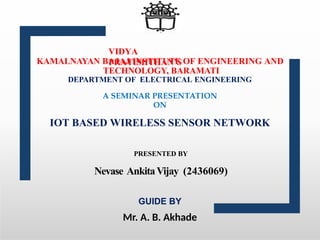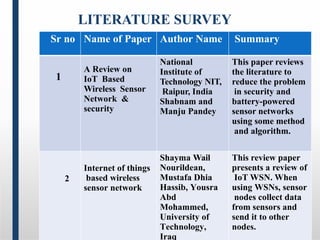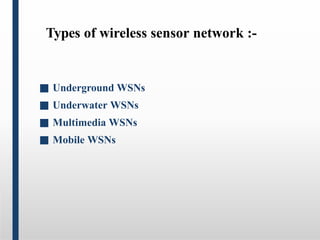Internet of thing Wireless sensor network
- 1. VIDYA PRATISHTHAN’S KAMALNAYAN BAJAJ INSTITUTE OF ENGINEERING AND TECHNOLOGY, BARAMATI DEPARTMENT OF ELECTRICAL ENGINEERING A SEMINAR PRESENTATION ON IOT BASED WIRELESS SENSOR NETWORK PRESENTED BY Nevase AnkitaVijay (2436069) GUIDE BY Mr. A. B. Akhade
- 2. CONTENTS 1. Introduction 2. Literature Survey 3. What is the wireless sensor network 4. Types of wireless sensor network 5. Advantages 6. Disadvantage 7. Applications 8. Future Scope 9. Conclusion 10. References
- 3. INTRODUCTION ■ Wireless sensor networks (WSNs) are a new class of wireless networks that are becoming very popular with a huge number of civilian and military applications. ■ A wireless sensor network (WSN) is a wireless network that contains distributed independent sensor devices that are meant to monitor physical or environmental conditions. ■ A WSN consists of a set of connected tiny sensor nodes, which communicate with each other and exchange information and data. These nodes obtain information on the environment such as temperature, pressure, humidity, and send this information to a base station.
- 4. LITERATURE SURVEY Sr no Name of Paper Author Name Summary 1 A Review on IoT Based Wireless Sensor Network & security National Institute of Technology NIT, Raipur, India Shabnam and Manju Pandey This paper reviews the literature to reduce the problem in security and battery-powered sensor networks using some method and algorithm. 2 Internet of things based wireless sensor network Shayma Wail Nourildean, Mustafa Dhia Hassib, Yousra Abd Mohammed, University of Technology, Iraq This review paper presents a review of IoT WSN. When using WSNs, sensor nodes collect data from sensors and send it to other nodes.
- 5. WHAT IS THE WIRELES SENSOR NETWORK ? ■ Sensor Network works for monitoring the physical world, that can sense, process and communicate. ■ A sensor network is a network of many tiny disposable low power devices called nodes. ■ A wireless sensor nodes consists of sensing , computing, communication and power components. ■ A WSNs usually consists of tens to thousands of such nodes that used for communicate for information sharing.
- 7. Types of wireless sensor network :- ■ Underground WSNs ■ Underwater WSNs ■ Multimedia WSNs ■ Mobile WSNs
- 8. UNDERGROUND WSNs:- ■ The WSNs networks consist of several sensor nodes that are hidden in the ground to monitor underground conditions. To relay information from the sensor nodes to the base station, additional sink nodes are located above the ground.
- 9. UNDERWATER WSNS The WSNs networks consist of several sensor nodes that are hidden in the ground to monitor underground conditions. Underwater, WSNs are equipped with a limited battery that cannot be recharged or replaced.
- 10. MULTIMEDIA WSNS These networks consist of low-cost sensor nodes equipped with microphones and cameras. These nodes are interconnected with each other over a wireless connection for data compression. multimedia contents require high bandwidth for the content to be delivered properly and easily.
- 11. MOBILE WSNS The mobile nodes can compute sense and communicate. Mobile wireless sensor networks are much more versatile than static sensor networks. The advantages of MWSN over static wireless sensor networks include better and improved coverage and better energy efficiency.
- 12. ADVANTAGES 1. Energy-Efficient 2. Flexible 3. Scalable 4. Real-time Data
- 13. DISADVANTAGES 1. Limited Range 2. Cost 3. Security 4. Power Consumption
- 14. APPLICATIONS ■ Military Applications ■ Environmental Applications ■ Health Applications ■ Home and Office Applications ■ Automotive Applications ■ Other Commercial Applications
- 15. Future Scope :- ■ As there is advancement in technology, the future developments in sensor nodes must produce very powerful and cost-effective devices. ■ In the future, sensor node may be used in applications like underwater acoustic sensor systems, sensing based cyber physical systems, time critical applications, cognitive sensing and spectrum management, security and privacy management [27]. ■ This section elaborates the various possibilities of further development in WSN applications.
- 16. ■ WSNs play an important part in IoT technology. ■ When using WSNs, sensor nodes collect data from sensors and send it to other nodes ■ WSNs possible today due to technological advancement in various domains. ■ WSNs consist of small nodes with sensing, computation and wireless communications capabilities. ■ WNSs are practical , cost effective and usefully. ■ WSNs provide a excellent information infrastructure for the remote monitoring, tracking and control of indoor and outdoor environments, industrial plants, and other applications. CONCLUSION
- 17. REFERENCES 1A. Rghioui and A. Oumnad, “Internet of things: surveys for measuring human activities from everywhere,” International Journal of Electrical and Computer Engineering (IJECE), vol. 7, no. 5, p. 2474, Oct. 2017, doi: 10.11591/ijece.v7i5.pp2474- 2482. 2A. H. Bagdadee, M. Z. Hoque, and L. Zhang, “IoT based wireless sensor network for power quality control in smart grid,” Procedia Computer Science, vol. 167, no. 2020, pp. 1148–1160, 2020, doi: 10.1016/j.procs.2020.03.417. 3J. M. Manpreet, “Simulation analysis of tree and mesh topologies in Zigbee network,” International Journal of Grid and Distributed Computing, vol. 8, no. 1, pp. 81–92, Feb. 2015, doi: 10.14257/ijgdc.2015.8.1.08. 4 A. Singh and I. Snigdh, “Modelling failure conditions in Zigbee based wireless sensor networks,” International Journal of Wireless and Microwave Technologies, vol. 7, no. 2, pp. 25–34, Mar. 2017, doi: 10.5815/ijwmt.2017.02.03.
- 18. Thank you !!!














![Future Scope :-
■ As there is advancement in technology, the future
developments in sensor nodes must produce very
powerful and cost-effective devices.
■ In the future, sensor node may be used in applications
like underwater acoustic sensor systems, sensing
based cyber physical systems, time critical
applications, cognitive sensing and spectrum
management, security and privacy management [27].
■ This section elaborates the various possibilities of
further development in WSN applications.](https://image.slidesharecdn.com/ankitaseminor-240921051814-7f6488c4/85/Internet-of-thing-Wireless-sensor-network-15-320.jpg)


